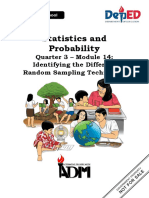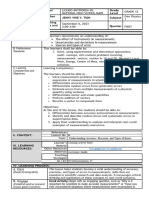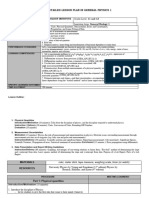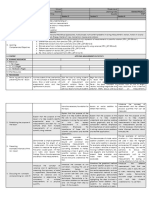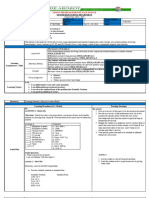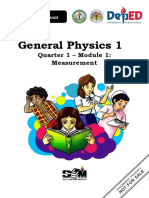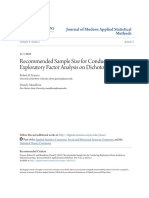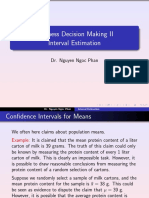Teaching Guide Quarter Number: Quarter 1 Subject Matter
Teaching Guide Quarter Number: Quarter 1 Subject Matter
Uploaded by
mina doteCopyright:
Available Formats
Teaching Guide Quarter Number: Quarter 1 Subject Matter
Teaching Guide Quarter Number: Quarter 1 Subject Matter
Uploaded by
mina doteOriginal Description:
Original Title
Copyright
Available Formats
Share this document
Did you find this document useful?
Is this content inappropriate?
Copyright:
Available Formats
Teaching Guide Quarter Number: Quarter 1 Subject Matter
Teaching Guide Quarter Number: Quarter 1 Subject Matter
Uploaded by
mina doteCopyright:
Available Formats
Subject Area: General Physics
TEACHING GUIDE
QUARTER NUMBER: Quarter 1
SUBJECT MATTER: Units, Physical Quantities, Measurement, Errors and Uncertainties,
Graphical Presentation, & Linear Fitting of Data
Units, Physical Quantities, Measurement, Errors and Uncertainties, Graph
TOPIC / LESSON NAME
Data
The learners demonstrate an understanding of:
CONTENT STANDARDS
1. Uncertainty of derived quantities
2. Error bars: Graphical analysis: linear fitting and transformation of fun
Solve, using experimental and theoretical approaches, multiconcept, rich
PERFORMANCE TASK measurement, vectors, motions in 1D, 2D, and 3D, Newton’s Laws, work,
impulse, and collisions
The learners should be able to:
Use the least count concept to estimate errors associated with sin
Ia4
LEARNING COMPETENCIES Estimate errors from multiple measurements of a physical quantit
Estimate the uncertainty of a derived quantity from the estimated
measured quantities STEM_GP12EU-Ia6
Estimate intercepts and slopes—and and their uncertainties—in e
dependence using the “eyeball method” and/or linear regression
TIME ALLOTMENT 180 mins.
ruler, meter stick, tape measure, timer (or watch)
MATERIALS
Teaching Guide for SHS (General Physics 1) by Jose Esgue
RESOURCES General Physics 1 by Santos, Gil, Ph. D, et Al.,
PROCEDURE
INTRODUCTION Checking of the research about the measurement of error or unce
Introduce the different measurement uncertainty and its represen
MOTIVATION Give the learners an example of a problem and show the best po
explains what uncertainty it represent.
Let the learners give their own example and show to the class ho
uncertainty.
INSTRUCTION Discuss to the learners about :
Approximating uncertainty for a single measurement
Approximating uncertainty in repetitive measurements
Describe standard deviations.
Standard deviation is a mathematical way to characterize the
It is used because of its link with normal distribution that is
statistics.
PRACTICE Given an example problem, let the learners find the following:
Measurement made in a single measurement
Average or mean for repetitive measurement
Average deviations for repetitive measurement
Standard deviations for the repetitive measurement
ENRICHMENT Let the learners have an analysis on approximating uncertainty us
Let them discuss their answers thoroughly in the class.
EVALUATION Let he learners answer the problem:
Using a timer, a pendulum has a period (T) of oscillation:
T= 0.44 seconds
If the measurement is repeated five times in a second:
Period 1: 0.46
Period 2: 0.44
PROCEDURE
Period 3: 0.45
Period 4: 0.44
Period 5: 0.41
What is the approximate of the periods? (use average or m
What is the differences of measurements? (use average de
You might also like
- Business Research Methods, OXFORD University Press, ISBN: 978 983 47074 77Document5 pagesBusiness Research Methods, OXFORD University Press, ISBN: 978 983 47074 77Muhammad SalmanNo ratings yet
- ADM SHS StatProb Q3 M14 Identifying The Different Random Sampling Techniques PDFDocument27 pagesADM SHS StatProb Q3 M14 Identifying The Different Random Sampling Techniques PDFRalph June Castro100% (4)
- Gen Phy. Module 2Document14 pagesGen Phy. Module 2Ronin100% (1)
- Study Guide for Practical Statistics for EducatorsFrom EverandStudy Guide for Practical Statistics for EducatorsRating: 4 out of 5 stars4/5 (1)
- Teaching Guide Quarter Number: Quarter 1 Subject MatterDocument2 pagesTeaching Guide Quarter Number: Quarter 1 Subject Mattermina doteNo ratings yet
- Gen Physics 1 - q1, Sept.6,2023Document3 pagesGen Physics 1 - q1, Sept.6,2023Jenny Vhie S. VinagreraNo ratings yet
- Week 1 TGDocument4 pagesWeek 1 TGJohn Paul ZagadoNo ratings yet
- Mid General Module 1Document23 pagesMid General Module 1Julliefe DuranteNo ratings yet
- Units, Physical Quantities, Measurement, Errors and Uncertainties, Graphical Presentation, and Linear Fitting of DataDocument87 pagesUnits, Physical Quantities, Measurement, Errors and Uncertainties, Graphical Presentation, and Linear Fitting of DataAlbert Jade Pontimayor LegariaNo ratings yet
- Week 1 TGDocument2 pagesWeek 1 TGJohn Paul ZagadoNo ratings yet
- 3.september 5-9Document3 pages3.september 5-9Lyka BugarinNo ratings yet
- General Physics 1 Lesson PlanDocument22 pagesGeneral Physics 1 Lesson PlanKazuya Sensei100% (1)
- Q1 - M1 - Lesson 3 PDFDocument15 pagesQ1 - M1 - Lesson 3 PDFFíre B DimayugaNo ratings yet
- Module in General Physics 1 Grade 12: DiscussionDocument18 pagesModule in General Physics 1 Grade 12: DiscussionDonna Mhae RolloqueNo ratings yet
- General PhysicsDocument23 pagesGeneral PhysicsSandraNo ratings yet
- Learning Plan in General Physics 12. FinalDocument8 pagesLearning Plan in General Physics 12. FinalMARIANO Kristelyn Carla NicoleNo ratings yet
- Biophysics Lab (Prelims Reviewer)Document5 pagesBiophysics Lab (Prelims Reviewer)Shaniah Azel GaodgaodNo ratings yet
- Phy 119 Course Compact - 2018 - 2019Document4 pagesPhy 119 Course Compact - 2018 - 2019omozokpea.miracleNo ratings yet
- General Chemistry 1Document83 pagesGeneral Chemistry 1ibano626No ratings yet
- Gen Phy 1 Quarter 1 Week 1Document4 pagesGen Phy 1 Quarter 1 Week 1Heidi YutucNo ratings yet
- Sample DLL AlexisDocument4 pagesSample DLL AlexisAlexis Castillo IINo ratings yet
- 01 Physical Quantities and UnitsDocument28 pages01 Physical Quantities and Unitsfisica2No ratings yet
- Measurements: by CHED On May 28, 2020Document5 pagesMeasurements: by CHED On May 28, 2020Raze De La CroixNo ratings yet
- DLL - W1 - 1ST SemDocument6 pagesDLL - W1 - 1ST SemMarvin DamascoNo ratings yet
- DLL Gen Physics 1 Q1 Week 1 - 2024-2025Document5 pagesDLL Gen Physics 1 Q1 Week 1 - 2024-2025marilou garciaNo ratings yet
- Module 1 - Physical Quantities and Units - CompleteDocument53 pagesModule 1 - Physical Quantities and Units - Completemarwanfake555No ratings yet
- Data Analysis LabDocument20 pagesData Analysis LabephremNo ratings yet
- General Physics Lesson ExemplarDocument9 pagesGeneral Physics Lesson ExemplaranthonydongonNo ratings yet
- Physics Module 1 Week 1 and 2Document14 pagesPhysics Module 1 Week 1 and 2Hallares, Maxine Kate F.No ratings yet
- Module Physics 1Document30 pagesModule Physics 1GMEET MAG INGAYNo ratings yet
- Statistics For Management - Unit - One-1Document9 pagesStatistics For Management - Unit - One-1msrakmogosNo ratings yet
- Course Outline Business Stats IIDocument5 pagesCourse Outline Business Stats IIOfficeNo ratings yet
- Introductory Physics Students' Treatment of Measurement UncertaintyDocument21 pagesIntroductory Physics Students' Treatment of Measurement UncertaintyBhavesh TrivediNo ratings yet
- Lesson-Plan W5Document4 pagesLesson-Plan W5Joyce IlaoNo ratings yet
- Keph 10203 EContent 2019Document24 pagesKeph 10203 EContent 2019Shravani RautNo ratings yet
- Units, Physical Quantities, Measurement, Errors and Uncertainties, Graphical Presentation, and Linear Fitting of DataDocument14 pagesUnits, Physical Quantities, Measurement, Errors and Uncertainties, Graphical Presentation, and Linear Fitting of DataNanzkie Andrei SamanNo ratings yet
- Unite Learning Plan in Math 7 Unit 3Document8 pagesUnite Learning Plan in Math 7 Unit 3jimmar poserio delacruzNo ratings yet
- CM6 - Mathematics As A Tool - Dispersion and CorrelationDocument18 pagesCM6 - Mathematics As A Tool - Dispersion and CorrelationLoeynahcNo ratings yet
- General Physics 1 q1 Week 1Document28 pagesGeneral Physics 1 q1 Week 1Baby Lyn SottoNo ratings yet
- Self Study Module Physics: The United Republic of Tanzania Ministry of Education and Vocational TrainingDocument33 pagesSelf Study Module Physics: The United Republic of Tanzania Ministry of Education and Vocational TrainingFranch Maverick Arellano LorillaNo ratings yet
- Session 1 Session 2 Session 3 Session 4: I. ObjectivesDocument3 pagesSession 1 Session 2 Session 3 Session 4: I. ObjectivesdenizsadayNo ratings yet
- Gen Physics Module 1Document6 pagesGen Physics Module 1Ganilyn PoncianoNo ratings yet
- CHAPTER 4 Realiability For TeachersDocument33 pagesCHAPTER 4 Realiability For TeachersMaria BustamanteNo ratings yet
- Kuw 315193Document135 pagesKuw 315193yqqpn7nkd5No ratings yet
- Units, Physical Quantities, Measurement, Errors and Uncertainties, Graphical Pre-Sentation, & Linear Fitting of DataDocument5 pagesUnits, Physical Quantities, Measurement, Errors and Uncertainties, Graphical Pre-Sentation, & Linear Fitting of DataFA SaganibNo ratings yet
- Tuesday (2:30-4:30) Wednesday (7:30-9:30) Tuesday (2:30-4:30)Document3 pagesTuesday (2:30-4:30) Wednesday (7:30-9:30) Tuesday (2:30-4:30)Miller YamsonNo ratings yet
- Psychological Assessment Module 2Document30 pagesPsychological Assessment Module 2Judyangaangan03No ratings yet
- A Concise Guide To Design ExperimentDocument39 pagesA Concise Guide To Design ExperimentFARAINo ratings yet
- RPS Measurement and Calibration Methods ExperimentsDocument5 pagesRPS Measurement and Calibration Methods ExperimentsARIF SURTONONo ratings yet
- New SyllabusDocument2 pagesNew SyllabusSankhadeep NagNo ratings yet
- SIPACKs in GENERAL PHYSICS 1 - Q1Document70 pagesSIPACKs in GENERAL PHYSICS 1 - Q1argon Joestar100% (3)
- Exemplar Physics Week 1 StudentsDocument24 pagesExemplar Physics Week 1 StudentsShaman King100% (1)
- Session 1/january 23 Session 2/january 24 Session 3/january 25 Session 4/january 26Document4 pagesSession 1/january 23 Session 2/january 24 Session 3/january 25 Session 4/january 26jun del rosarioNo ratings yet
- SP Iii-17Document6 pagesSP Iii-17Jomar DiegoNo ratings yet
- Section 1.1: Section 1.2: Measurement Section 1.3: Graphing DataDocument33 pagesSection 1.1: Section 1.2: Measurement Section 1.3: Graphing DataabcdNo ratings yet
- Research Chapter 1Document13 pagesResearch Chapter 1PASCUA, Louisse I.No ratings yet
- 2205.04102v2Document9 pages2205.04102v2Shalltear BloodFallenNo ratings yet
- Statistic DLL 5Document5 pagesStatistic DLL 5Raymart ValbarezNo ratings yet
- A Concise Guide To Design ExperimentDocument39 pagesA Concise Guide To Design Experimentmotieu56No ratings yet
- Q1 General Physics 12 - Module 1Document23 pagesQ1 General Physics 12 - Module 1Glaiza GianganNo ratings yet
- Biophysics Lab (Prelims Reviewer)Document6 pagesBiophysics Lab (Prelims Reviewer)Shaniah Azel GaodgaodNo ratings yet
- Measurement, Accuracy and Precision PDFDocument19 pagesMeasurement, Accuracy and Precision PDFAyush ZalaNo ratings yet
- Faculty Matrix NewDocument1 pageFaculty Matrix Newmina dote100% (1)
- Math Grade 10Document3 pagesMath Grade 10mina doteNo ratings yet
- PART2Document4 pagesPART2mina doteNo ratings yet
- Questionnaire (Stat)Document2 pagesQuestionnaire (Stat)mina doteNo ratings yet
- Faculty Performance Appraisal Report (Draft1)Document3 pagesFaculty Performance Appraisal Report (Draft1)mina dote100% (2)
- Division Memorandum No. 181, s.2021Document18 pagesDivision Memorandum No. 181, s.2021mina doteNo ratings yet
- Riemann Sums and The Definite Integral: Basic Calculus Grade 12 Quarter 4 May, 2021Document4 pagesRiemann Sums and The Definite Integral: Basic Calculus Grade 12 Quarter 4 May, 2021mina doteNo ratings yet
- Recommended Sample Size For Conducting Exploratory Factor AnalysiDocument11 pagesRecommended Sample Size For Conducting Exploratory Factor AnalysimedijumNo ratings yet
- Six Steps in Regression Analysis by Hasan Nagra Econometrics Sir Atif NotesDocument30 pagesSix Steps in Regression Analysis by Hasan Nagra Econometrics Sir Atif NotesMUHAMMAD HASAN NAGRANo ratings yet
- Meta-Analysis of ProportionsDocument15 pagesMeta-Analysis of ProportionsIWAN KUNCORONo ratings yet
- Survey Method ResearchDocument19 pagesSurvey Method ResearchKoorosh GhotbNo ratings yet
- Cognition and The BrainDocument12 pagesCognition and The BrainInterfan_allinNo ratings yet
- Humanistic Method of ResearchDocument4 pagesHumanistic Method of Researchgdhssjjssj100% (1)
- 7 Repl - Quant Blue Dye in Comm Drinks - ModFall2012Document7 pages7 Repl - Quant Blue Dye in Comm Drinks - ModFall2012Zohaib AliNo ratings yet
- Artikel - Ni Putu Novita Verdyana PutriDocument19 pagesArtikel - Ni Putu Novita Verdyana PutriNi Putu Novita Verdyana PutriNo ratings yet
- Research Paper With Anova TestDocument4 pagesResearch Paper With Anova Testc9snjtdx100% (1)
- A 18-Page Statistics & Data Science Cheat SheetsDocument18 pagesA 18-Page Statistics & Data Science Cheat SheetsAniket AggarwalNo ratings yet
- APA 6 BGS QUANTITATIVE Research Paper 03 2015 PDFDocument50 pagesAPA 6 BGS QUANTITATIVE Research Paper 03 2015 PDFJakie UbinaNo ratings yet
- Reviews For Final Test - 1Document6 pagesReviews For Final Test - 1Lâm Mỹ HoaNo ratings yet
- Pengaruh Pelatihan Bantuan Hidup Dasar Terhadap Pengetahuan Dan Motivasi Menolong Korban Kecelakaan Lalu LintasDocument7 pagesPengaruh Pelatihan Bantuan Hidup Dasar Terhadap Pengetahuan Dan Motivasi Menolong Korban Kecelakaan Lalu LintasIrawati HidayahNo ratings yet
- PDF Hypothesis Testing Random Motors Project DDDocument6 pagesPDF Hypothesis Testing Random Motors Project DDPrathamesh ShettyNo ratings yet
- Stats Exam QnADocument9 pagesStats Exam QnApavansam6No ratings yet
- One Way Anova (I) : - Between Subject ExperimentDocument29 pagesOne Way Anova (I) : - Between Subject Experimentfeddy hendriyawanNo ratings yet
- Experimental Psychology Final Exam ReviewerDocument13 pagesExperimental Psychology Final Exam Revieweralteahmae31No ratings yet
- Marketing XLRIDocument7 pagesMarketing XLRIchinum1No ratings yet
- TOK Essay Examiner Prep Notes 2019Document18 pagesTOK Essay Examiner Prep Notes 2019Aziz KarimNo ratings yet
- Study Plan - SociologyDocument16 pagesStudy Plan - SociologyAfzaal AhmadNo ratings yet
- 20200207124552assignment w5Document2 pages20200207124552assignment w5kelvinNo ratings yet
- InferenceForMeans Hotelling PDFDocument23 pagesInferenceForMeans Hotelling PDFGech YouNo ratings yet
- May 26 - 29 Science Lessons GinoDocument4 pagesMay 26 - 29 Science Lessons Ginoapi-316853595No ratings yet
- Business Decision Making II Interval Estimation: Dr. Nguyen Ngoc PhanDocument16 pagesBusiness Decision Making II Interval Estimation: Dr. Nguyen Ngoc PhanUyen ThuNo ratings yet
- Lecture 4 - Actg Research Methods (Chapter 3 - Methodology)Document22 pagesLecture 4 - Actg Research Methods (Chapter 3 - Methodology)markNo ratings yet
- Research Methodology For Economic Sciences - 1Document22 pagesResearch Methodology For Economic Sciences - 1Givemore ChiwanzaNo ratings yet
- Action Research JLoDocument55 pagesAction Research JLoJulieto Bacsan Sumatra Jr.100% (1)
- Ch06 OriginalDocument36 pagesCh06 OriginalAbdisaa GirmaNo ratings yet

